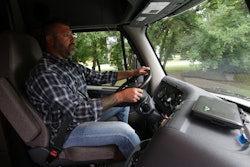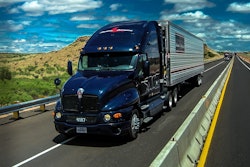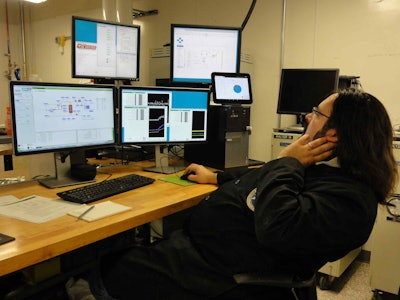
Grist and saw mills once lined the banks of the Genesee River in downtown Rochester, N.Y., drawing hydropower from a large waterfall.
For a period, Rochester was known as Flour City before manufacturing expanded with the completion of the Erie Canal in 1825. Connected to New York City by the waterway, raw materials poured in and finished goods shipped out on barges towed by four-legged horsepower.
Its manufacturing output climaxed in the 1980s as the headquarters of Kodak, Xerox and Bausch and Lomb.
Many blue-collar manufacturing jobs have since disappeared from Rochester, but its heritage as an industrial powerhouse lives on. New information technology is being developed here on a large scale.
Predicting asset health
The roots of Vnomics, a fleet technology company, began in 2002 when the Office of Naval Research (ONR) contracted the Rochester Institute of Technology (RIT) to modernize some battle vehicles for the U.S. Marine Corps.
RIT is one of the nation’s largest private universities and is world-renown for science and engineering research. The ONR started a new Sense and Response Logistics program and asked the Center for Integrated Manufacturing Studies at RIT to research the Light Armored Vehicle (LAV) and other Marine platforms.
 Vnomics stems from a research project to predict maintenance for the Light Armored Vehicle (LAV) of the U.S. Marine Corps.
Vnomics stems from a research project to predict maintenance for the Light Armored Vehicle (LAV) of the U.S. Marine Corps.The aging LAV fleet rolled off the production line in 1982 and, as such, did not have electronics or diagnostic capabilities found in modern vehicles. An engineering team at RIT conducted extensive failure analysis of its components, and developed sensors and a controller area network (CAN) to capture real-time operating data.
While working on this and other military projects, the Center for Integrated Manufacturing Studies developed the Asset Health Monitoring system. The system validates the accuracy of sensor data and predicts vehicle maintenance needs using advanced data models and algorithms.
Today, onboard systems on the vehicles give Marine operators and commanders real-time predictive maintenance information. An LAV operator can see the remaining miles to a breakdown, for example, and status indicators — in green, yellow or red — for the critical parameters like speed and temperature of planetary gear drives.
Going commercial
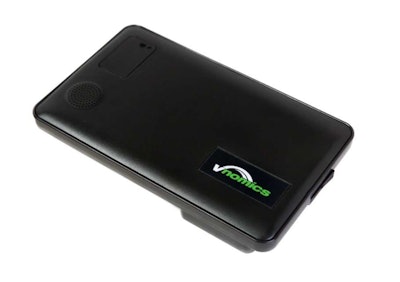 The edge device for the True Fuel system instantly analyzes vehicle data to determine actual and potential mpg.
The edge device for the True Fuel system instantly analyzes vehicle data to determine actual and potential mpg.To capitalize on the intellectual property (IP) of its Asset Health Monitoring system, RIT spun off Vnomics in 2008. Rather than focus on predictive fleet maintenance, Vnomics used the IP to create a system that can predict and optimize the fuel performance of diesel-powered trucks.
Ed McCarthy was an engineer at RIT before he joined Vnomics and became its vice president of customer success and operations. He and other Vnomics executives met with CCJ at the company’s Pittsford, N.Y., office on Tuesday, Nov. 29, to discuss True Fuel, a product the company launched in early 2016.
Vnomics says fleets are seeing their mpg improve by an average of nine percent in the first 12 months of deploying True Fuel and saving $160 per truck per month in fuel. This correlates to $1,920 annually per truck.
The hardware of True Fuel costs less than $300 and the monthly subscription is $30.
Edge computing
True Fuel is an Internet of Things (IoT) system with “edge” computing and analytics, explains Lloyd Palum, chief technology officer of Vnomics. The edge is an android computing device that installs in vehicles and captures real-time data to perform advanced fuel analysis.
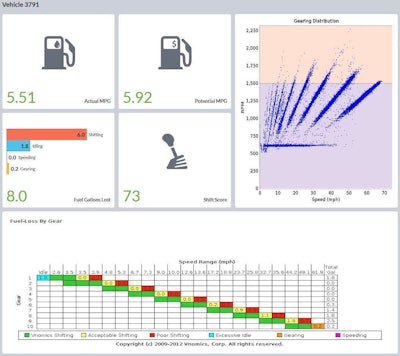 True Fuel gives real-time fuel coaching to drivers and delivers a unique set of metrics to fleet managers.
True Fuel gives real-time fuel coaching to drivers and delivers a unique set of metrics to fleet managers.The edge device sits on top of the dashboard, or under it, with cable connections to the vehicle’s diagnostics port and to a cellular modem the size of a hockey puck.
As part of the install, Vnomics configures the True Fuel data model to match the engine, drive train, torque curve, and other parameters of the vehicle. From the first ignition, a continuous stream of ECM and sensor data feeds the data model, which uses “unsupervised” machine learning to determine the optimal amount of fuel the vehicle requires to do the work at any time, Palum explains.
More than 500,000 data points are collected per truck every month, and all of it is processed in real time by the edge device. Information is then transmitted to Vnomics’ servers in the cloud.
The technology gives real-time fuel coaching to drivers and delivers a unique set of metrics to fleet managers, neatly organized into nine panels, or tiles, in an online fuel management dashboard.
Reaching the potential
True Fuel calculates the actual and potential mpg of a vehicle in motion. Fuel potential is the maximum mpg that the vehicle is capable of achieving.
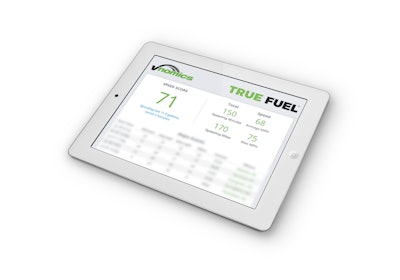 Vnomics calculates a daily score for drivers that shows how they performed compared to their potential.
Vnomics calculates a daily score for drivers that shows how they performed compared to their potential.Because True Fuel knows the actual and potential mpg of a vehicle, it captures the difference — the amount of fuel wasted or lost. The model associates fuel loss with specific driver behaviors like speeding, idling, and engine control.
In the cab, True Fuel gives drivers instant audible feedback — a distinct set of tones — when fuel use exceeds the boundaries for engine control (RPMs), speed and idling.
At the end of a trip (an ignition on/off event), drivers get an audible score. On a scale of 100, the score is a way for drivers to quickly assess their fuel efficiency and benchmark their efforts to improve.
For instance, a score of 73 indicates the driver could have performed 27 percent better. The difference, or loss, is caused by behaviors that drivers control. If a driver is using an automatic transmission, for example, easing up on the pedal before reaching 1,600 RPM — before an audible alert — would result in the truck shifting up at a lower RPM to save fuel.
Other behaviors drivers can improve are engine idling and speeding. An alert sounds when the idling exceeds three minutes, for instance. Drivers also get an alert when they exceed a top speed threshold, such as 65 mph.
The idling and speed alerts are configurable by fleet. The RPM threshold is determined by True Fuel’s data model and is specific to each vehicle and engine.
True Fuel normalizes the scores for factors outside of driver control like topography, road speed, and load weight, Palum says. Additionally, it captures the fuel loss associated with a truck not being geared correctly for the operation. If a driver exceeds 1,600 RPMs while in top gear and is going less than the top speed of 65 mph, for instance, True Fuel records the fuel loss associated with this event, he says.
A digital twin
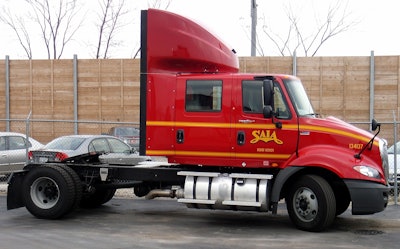 Saia was one of Vnomics’ first customers to use its technology to improve fuel efficiency.
Saia was one of Vnomics’ first customers to use its technology to improve fuel efficiency.Vnomics has patents for its methods to calculate fuel potential and fuel loss, and for real-time driver coaching in the cab, Palum says. The system has broader capabilities beyond these patents.
One ongoing development is the creation of what Palum calls “digital twin” models.
All of the analysis and sensor data captured by the edge device — wheel speeds, the RPMs, torque, fuel rate, locations and more — is mapped to a time-series database in the cloud, he says.
The replicate or “digital twin” model in the cloud can be used to gain a deeper understanding of fuel performance, he says. Possibilities include finding the fuel impact of a certain route or load, or detecting a drop in fuel economy due to a maintenance problem.
The model can evaluate new fuel-saving technology like trailer skirts or aero packages as well. For example, when trying to determine the fuel impact of a trailer skirt, a fleet could look at the mpg potential of a vehicle before and after the skirt was used. If the potential mpg is 6 mph before and 6.5 mpg after, the difference of 0.5 mpg is directly attributed to the use of the trailer skirt, explains Bob Magnant, vice president of product management.
“We are well positioned because we have this platform,” he says. “We have an approach in place that allows us to isolate the driver, uniquely in the industry, and are able to say what are all of the things that are impacting a fleet’s fuel economy.”



